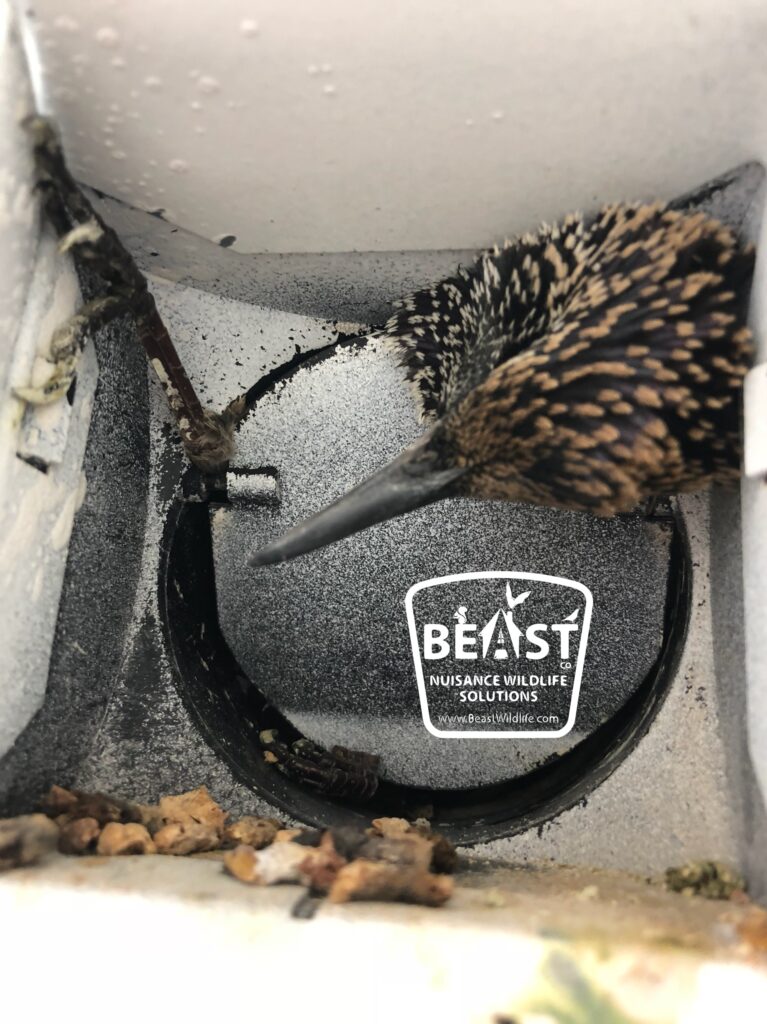One of the worst nuisance birds for industrial facilities is the starling. They are dark in color and chubby with squared tails. Their bills are long and slender and they look more dull in color in the summer months. These protected birds love to invade airports, parking lots, golf courses and farms. They love populated areas as well and will aggressively take over areas (sometimes by the thousands). Where they go, damage is sure to follow.

STARLING BEHAVIOR
Judging by the size of most groups, you would think that starlings produce more offspring than the 8 or so per year they make. They breed twice a year and the fledglings are in the nest with the parents for about 25 days. They like warmer climates and tend to migrate south during colder months and they can travel quite far to find food during the day.
Starlings are nesting birds and they will build nests in trees, holes and birdhouses. They only need about 1 ½ inch openings to enter a space to nest in. Sometimes, they even steal the nests other birds have made. This is not a particularly nice species of bird.
DAMAGES FROM STARLINGS
A variety of damages can be a result from a starling flocks. First, the outside of the building. Canvas awnings, paint and even plastic are susceptible to the acid in the bird droppings. This causes corrosion that can even affect concrete and brick. Vents and gutters can be clogged with nesting materials causing water damage. Walkways can become slippery from droppings and create dangerous walking conditions for employees and patrons. Inside the building you will have possible health risks due to parasites and bacteria that has entered from your HVAC system and circulated throughout the location. Respiratory issues can be a result of this contamination. In larger areas like airports, starlings can be a huge problem for planes. There is potential for plane damage if the birds are flying near them. They can even be problematic on farms. Contamination from farm to farm can occur when the starlings eat parts of the livestock feed. They can also damage crops by eating them. The damages can be extensive.

PREVENTING STARLING INFESTATION
There are a few things you can do to discourage starlings from roosting or nesting on your property. Removing food and trimming trees can be helpful. Without available food, your property will not be an ideal location for them. You can also exclude them from your buildings by sealing off any possible entry points. Any hole or space over 1 inch should be closed to keep them from entering. This includes vents on the roof as well.
DETERRENTS FOR STARLINGS
- There are a large variety of options for deterring starlings. The best option for your business depends largely on what type of buildings or property you have.
- Shock strips- Electrified strips that work well on ledges, rooftops and signage.
- Spike strips- Stainless steel spikes that deter birds like starlings and pigeons from roosting on rooftops, balconies, signs, ceiling beams and other structural areas.
- Bird slides- Slanted inserts that create a slippery edge so birds can not land on them.
- airport hangers. Theme parks, amphitheaters and big box stores can also benefit from netting.
- Bird netting- Long lasting netting that is perfect for large areas. Can be used indoors and outdoors to keep birds from canopies, warehouses, golf courses and Starling traps- boxes that can be placed to humanely trap the birds so they can be released in a safe place.
- Optical gel- an option that combines visual, smell and touch deterrent that can be placed almost anywhere. Can be used for signage, ledges, beams, balconies, HVAC and balconies. It tricks birds into thinking they are near fire.
- Eagle eye- Laser deterrent that is great for airports and farms
- Liquid bird repellent-can be sprayed in farm areas, golf courses and other open areas to deter the birds from gathering there.
We can install any necessary systems for you after we inspect your property and present your best options for starling control.
